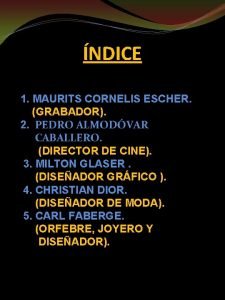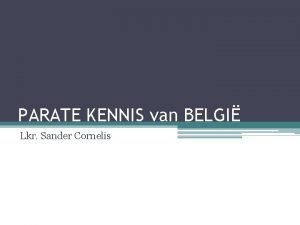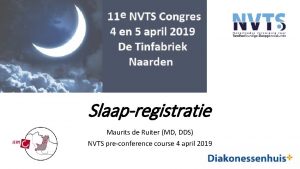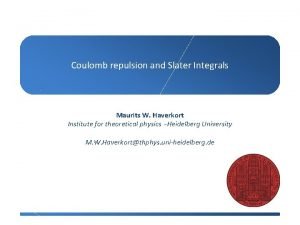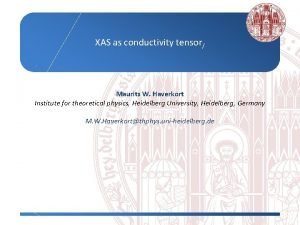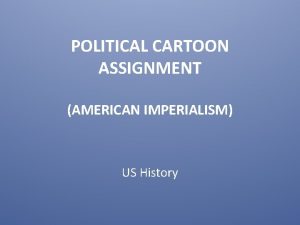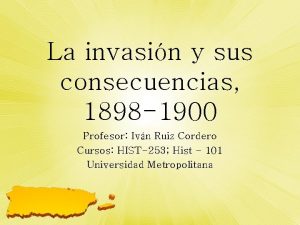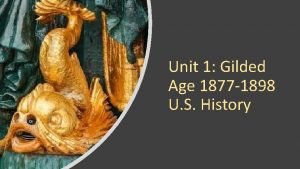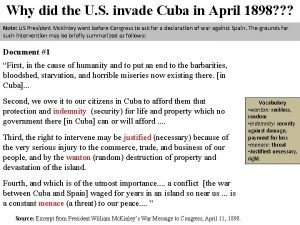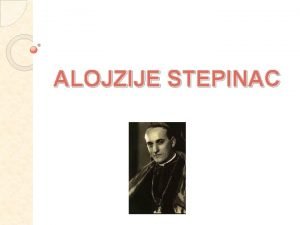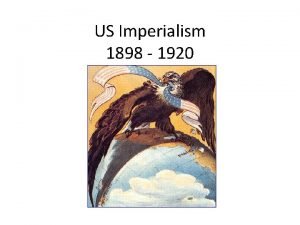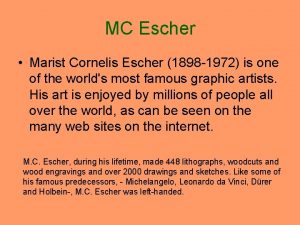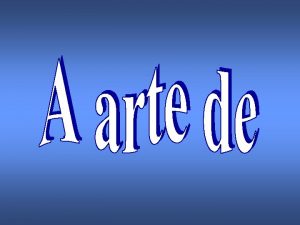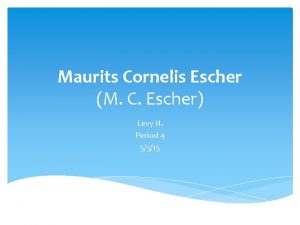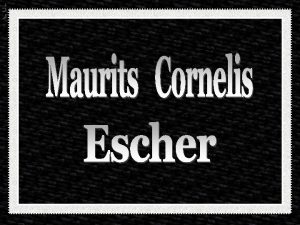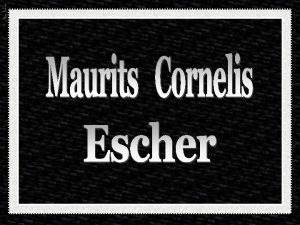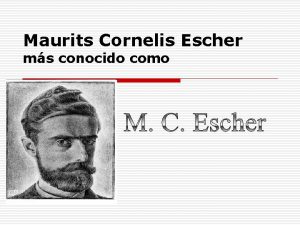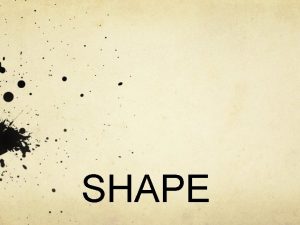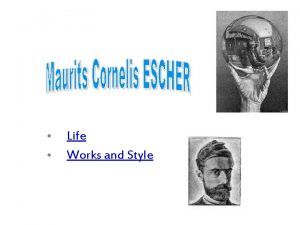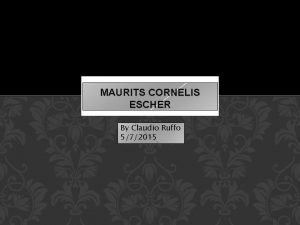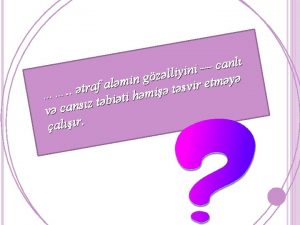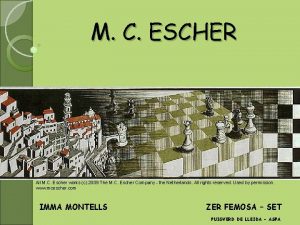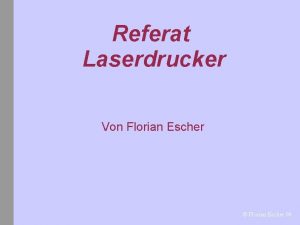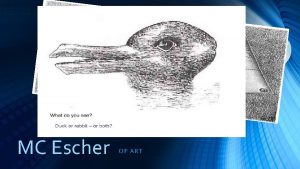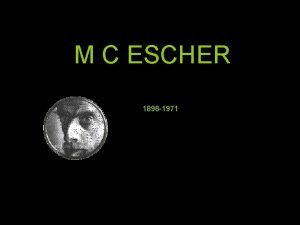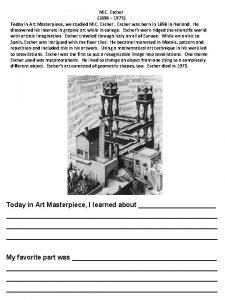Maurits Cornelis Escher 1898 1972 M C Escher


















- Slides: 18

Maurits Cornelis Escher (1898 -1972)

M. C. Escher He was born in Leeuwarden, the Netherlands, as the fourth and youngest son of a civil engineer. After 5 years the family moved to Arnhem where Escher spent most of his youth. After failing his high school exams, Maurits ultimately was enrolled in the School for Architecture and Decorative Arts in Haarlem. After only one week, he informed his father that he would rather study graphic art instead of architecture, as he had shown his drawings and linoleum cuts to his graphic teacher Samuel Jessurun de Mesquita, who encouraged him to continue with graphic arts. Mesquita would remain as a mentor throughout Escher career until Mesquita was taken away to a concentration camp during the war.

Early Work 1916 -1922 White Cat (1919) Woodcut and Fiet van Stolk (1918) Linoleum Cut

M. C. Escher After finishing school, he traveled extensively through Italy, where he met his wife Jetta Umiker, whom he married in 1924. They settled in Rome, where they stayed until 1935. During these 11 years, Escher would travel each year throughout Italy, drawing and sketching for the various prints he would make when he returned home. Escher spent time in the Southern Italian countryside with the villages set on hills and felt he “had to draw everything. ”

Italian Period 1922 - 1935

Italian Period 1922 - 1935 Tropea, Calabria (1931) Lithograph and The Bridge (1930) Lithograph shows the influence of the Italian landscape on his work.

Inspiration in Spain During the lead-up to World War II, Escher felt he could no longer keep his family in Fascist controlled Italy. He first moved them to Switzerland but he hated the snow filled winters and spent as much time as he could in Spain. In Spain, he discovered the beautiful palace and mosaics of Alhambra. He became fascinated with tiling and the mathematically beautiful designs and spent most of his time during the war exploring these designs.

Influence of Alhambra Spanish Palace built by the Moors during their time in Spain

Tessellations A tessellation is created when a shape is repeated over and over again covering a plane without any gaps or overlaps.

The Reptiles (1943) print illustrates one of Escher’s predilections – the bringing to life of an abstract structure. By arranging a few small personal effects around the notebook – a glass, a plant, a book – Escher suggests the presence of the artist or rather the temporary absence, during which is drawing begins to have a life of its own.

The Drawing Hands (1948) again illustrates his proclivity for combining art and reality.

Optical Illusion Escher loved to explore spatial experiences. He experimented with dimensions, reflections, illusions. He would blend height and depth, creating a picture within a picture as he did in Hand with Reflecting Sphere (1935) and Puddle (1952).

More Illusions Post 1937 Escher moved away from visible reality to pictorial constructions based on the penrose triangle. In Relativity, figures and spaces are in impossible situations where they possess an absurd strangeness. Look at the 2 figures in upper part of print who are walking on same stairs, in same direction, but 1 is ascending and 1 is descending. Each plane is given not the usual single function, but 3. Each flat surface is at the same time wall, floor and ceiling. Relativity (1953)

More Mathematical Exploration

Making a Tessellation Start with a shape that can be tessellated – a square, rectangle, equilateral triangle, pentagon, etc. Make one of the sides “funky” by cutting out of the shape on one side. Add your funky cut-out to the opposite side.

Making a Tessellation Do the same to the other pair of parallel sides of the square. Use your imagination. Turn the shape into a creature or design. Try making one object face one way, and the other object face the opposite way.

Making a Tessellation Be Creative! Add color and texture.

Making a Tessellation Trace and Tessellate!
 Mc escher biografia
Mc escher biografia Piet cornelis mondrian
Piet cornelis mondrian Rute cornelis de houtman
Rute cornelis de houtman Cornelis guling
Cornelis guling Sander cornelis
Sander cornelis Pieter cornelis mondriaan
Pieter cornelis mondriaan Maurits butter
Maurits butter Fakultas ilmu komputer gunadarma
Fakultas ilmu komputer gunadarma Dr van tulder
Dr van tulder Nvts
Nvts Slater integrals
Slater integrals Maurits w. haverkort
Maurits w. haverkort Imperialism political cartoon
Imperialism political cartoon Consecuencias de la invasion norteamericana 1898
Consecuencias de la invasion norteamericana 1898 La pequeña caperucita roja le petit journal 1898
La pequeña caperucita roja le petit journal 1898 The gilded age 1877 to 1898 worksheet answers
The gilded age 1877 to 1898 worksheet answers Why did the united states invade cuba in 1898
Why did the united states invade cuba in 1898 Rodio 1898
Rodio 1898 1898 to 1920
1898 to 1920
